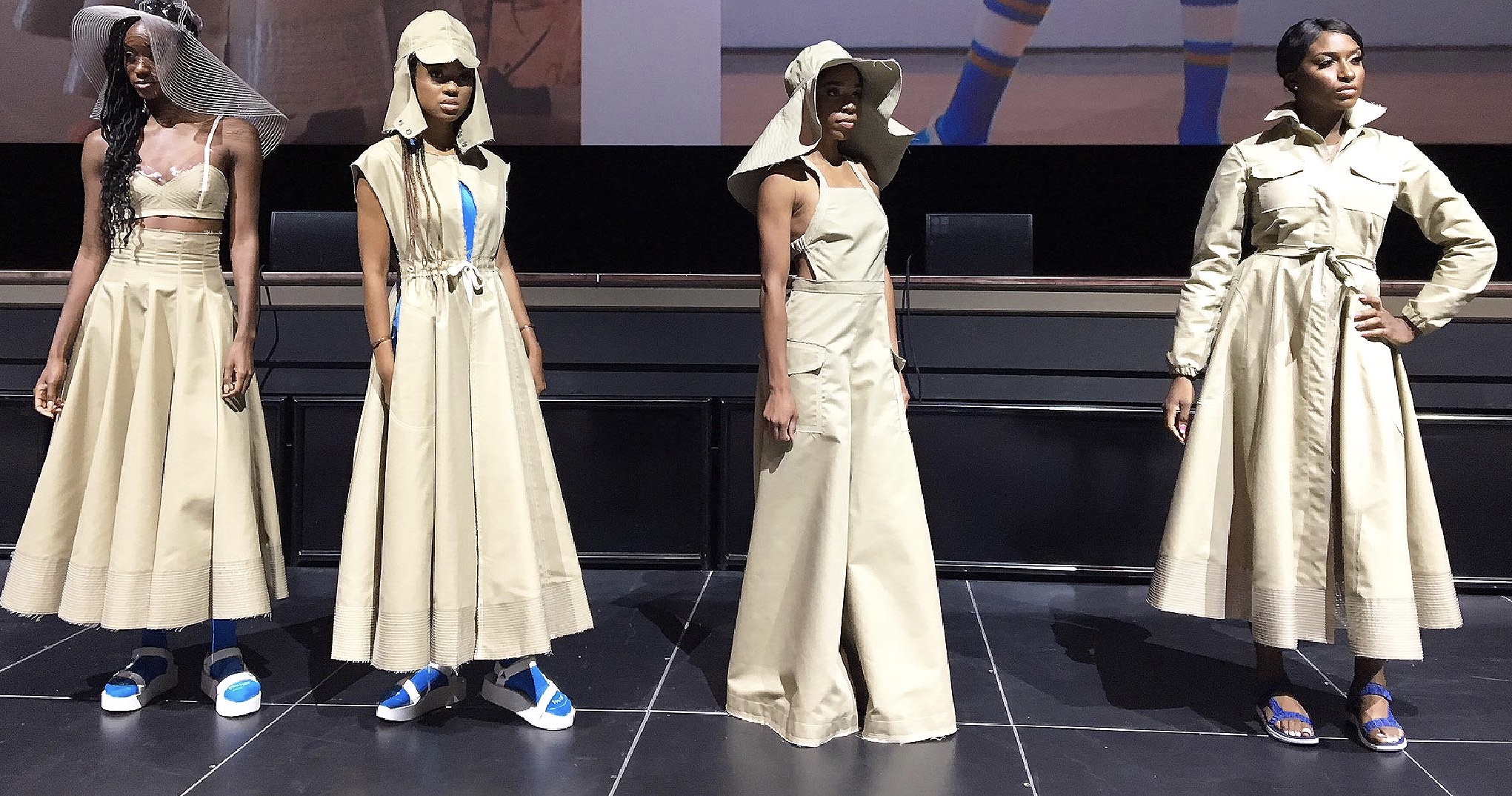
Clothes crafted from castoff water bottles featured at Flint Fit Capitol Theatre show (Photo by Patsy Isenberg)
By Patsy Isenberg
Key figures from Flint Fit, a project to turn 90,000 water bottles into fashion, were on hand at The Capitol Theatre Sept. 15 to show Flint what became of the truckload of plastic collected in the city last fall.
The clothes, created by a triumvirate of artists in New York City; thread and material manufacturers in Greensboro, North Carolina; and Flint-based sewers at the St. Luke N.E.W. Life Center aren’t available to the public yet. But the high-fashion prototypes — appropriately in water-based items like rainwear, swimsuits and hats–suggested a positive transformation from one outcome of the city’s woes.
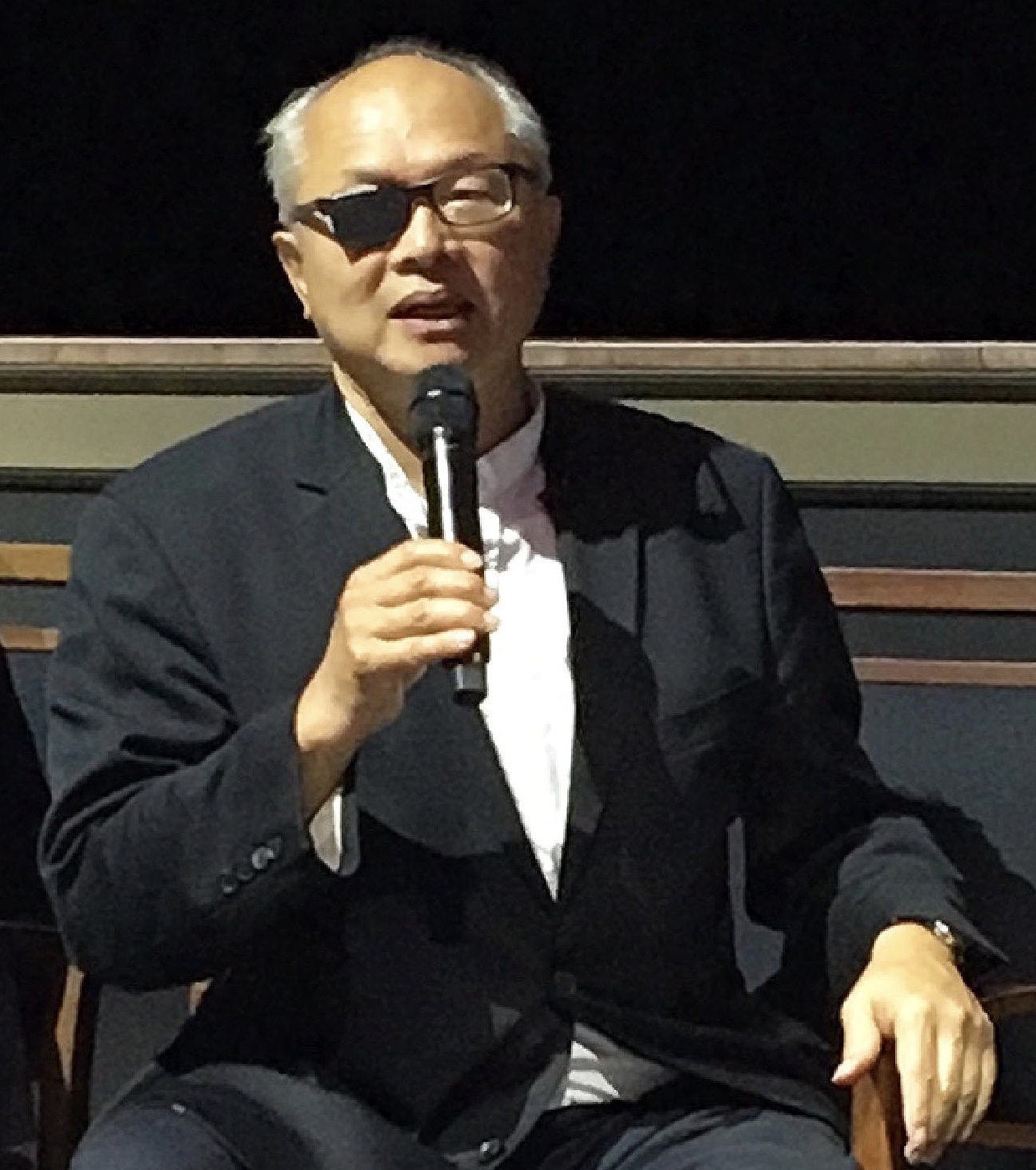
Conceptual artist and “Flint Fit” guru Mel Chin (photo by Patsy Isenberg)
Artist Mel Chin, 67, an artist who conceived the idea; Tracy Reese, 54, the designer of the fashions; and a documentary film maker, Ben Premeaux, were all there to report on what took place in the last year to make it happen. The prototypes of the designs were sewn at The N.E.W. Life Center in Flint, and several of the sewers were there.
In comments to the audience, Chin, whose work had been commissioned by the Queens Museum in New York City, emphasized how important the people of Flint were, and are, to the project and offered many thanks.
One of the N.E.W. Life sewers voiced appreciation for the opportunity. “It felt like you were part of something bigger…like you were part of a solution,” Rebecca Arnell said, “and like we were showing the world that we are not just abandoned homes… not just poverty, not just all these things that have been shown. We are a group of women and men and citizens that can do amazing things.”
Further evidence of N.E.W. Life Center’s hard work and skill were noted by Marty Calhoun, another one of the sewers, “We were all pushed to do sewing at a higher level.”
Reese called the women “Amazons.” She and her assistant Hung Chow, who did the draping and pattern making for the garments, had made several visits back to Flint and spent many hours at the center to oversee the process.
The Collection
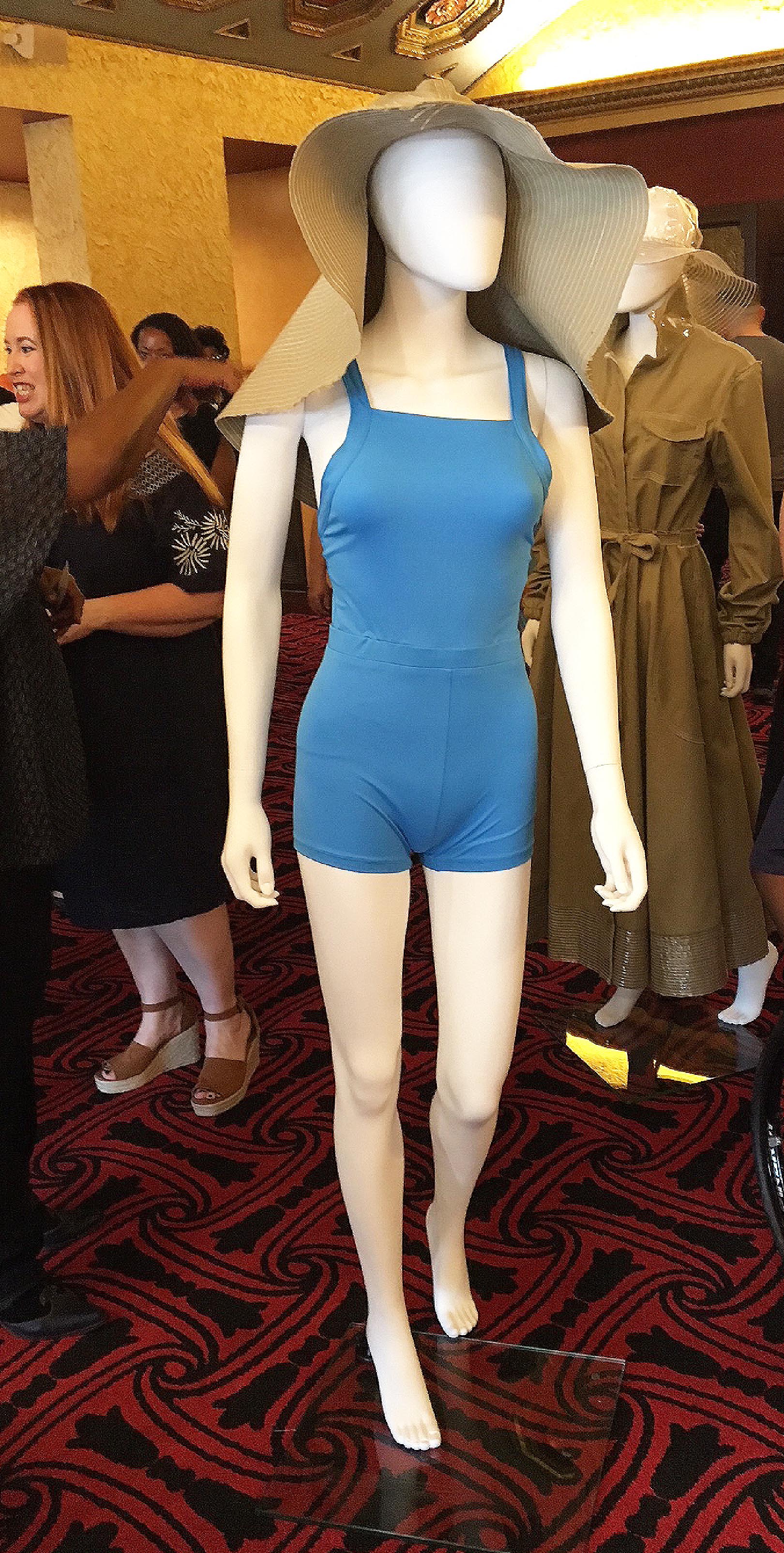
Swim suit and hat, all from water bottles (Photo by Patsy Isenberg)
At the Capitol Theatre the water bottles transformed into fashions were displayed on manikins in the lobby. The designs were couture designs, very beautiful, edgy and voluminous, typical of a designer’s introductory collection and not what the average consumer might wear.
The garments were constructed from three different materials. Most were made from a smooth crisp khaki which was 50 percent from the recycled bottles and 50 percent cotton. A selection of swimwear was made from a bright blue knitted material that was 100 percent recycled material from the bottles. The third material was clear, all from the bottles, and used for hats, overlays and embellishments. There was also a craft table set up for children to experiment and learn a little about fashion design.
Runway Show
In a short runway show, four models wearing Reese’s fashions from the collection walked down the center aisle toward the stage and posed in front of still photographs from an exhibit at the Queens Museum projected behind them. It was quite impressive and a nice punctuation mark to the film. The models were obviously professionals and posed on the runway for photographs.
The Documentary: “Repurpose, the Story of Flint Fit”
Premeaux, who is from Texas, as is Chin, said the film, screened for the audience at the Capitol show, is his first full-length documentary. He said it’s still being edited but when complete possibly will be shown at film festivals. Premeaux said he plans to make the film available eventually through an accessible online link.
The film begins with a bird’s eye view of The Flint River and quickly moves to the fateful pushing of the button that switched Flint’s water access to the Flint River. Premeaux emphasized he needed to include footage of all three locations of the triangle that makes up the Flint Fit project, Flint; Greensboro, North Carolina; New York City; and then back to Flint. He included scenes related to the water crisis and the problems that arose from it. He captured the streets of Flint, often littered with water bottles. He included interviews with Dr. Mona Hanna-Attisha, who sheds light on medical issues, activist Melissa Mays and others. There’s footage of the press conference last fall at The N.E.W. Life Center where the project was announced. Those involved with that important aspect of the project are included in the first Flint part of the triangle. Premeaux then shows the empty water bottles being delivered to the recycling plant, Unifi, Inc., in Greensboro. The process is visually shown as to how the thread needed for manufacturing the fabric is created from the bottles. Then the film shifts to New York City where Chin and Reese confer about the designs and their vision for the final project.
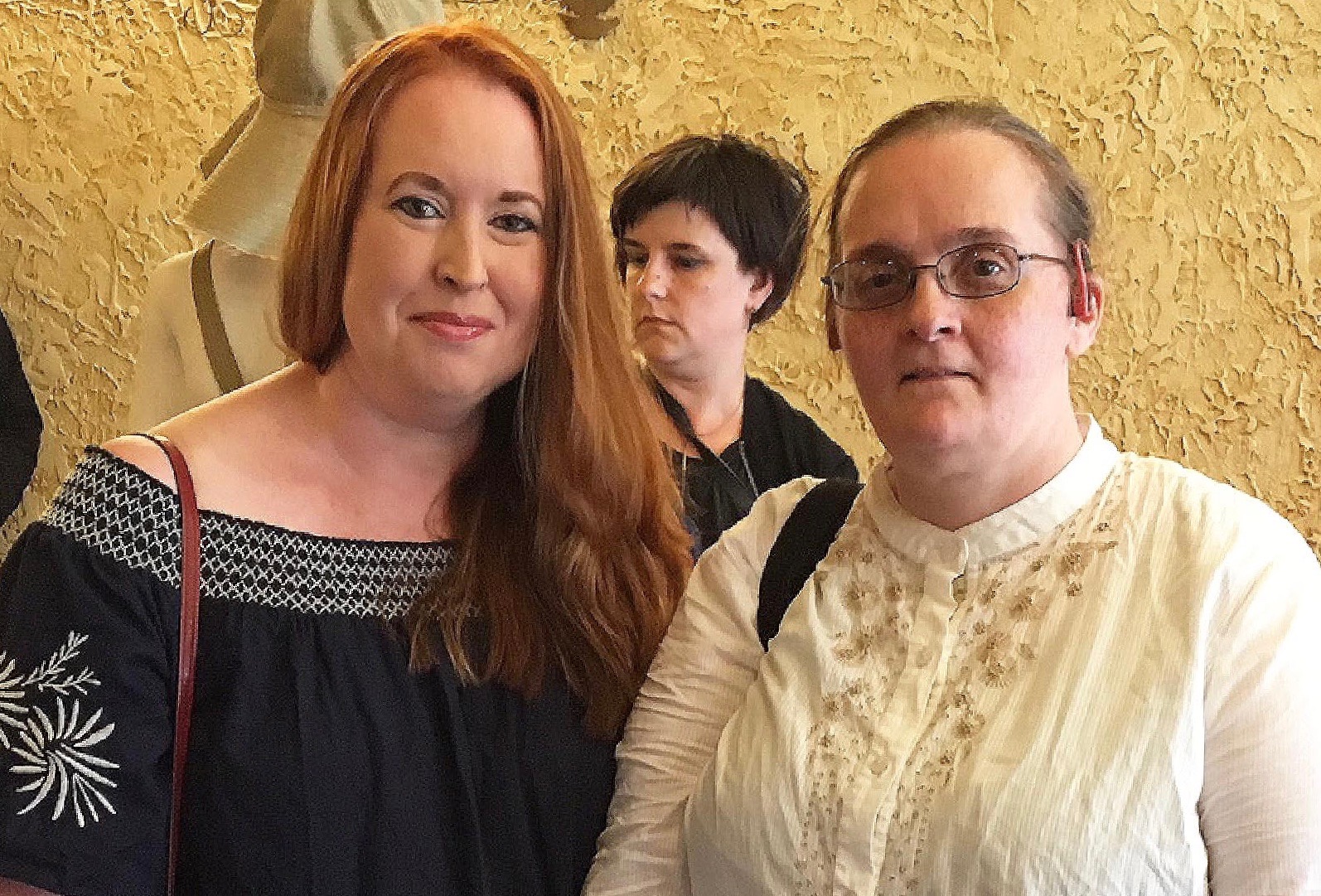
Flint-based Flint Fit sewers Rebecca Arnell (left) and Nicole Zepp (Photo by Patsy Isenberg)
Premeaux captured the fashion show that opened the exhibit of Chin’s “All Over the Place” project at the Queens Museum in New York City this summer. Eight people from Flint were invited to attend and participate. Tameka Davis, Dorothea Guice, Mary Kryza, Melissa Mays, Lathan and Bishop Jefferson, Liberty Bell and Dr. Lee Bell were each ceremoniously walked into the venue accompanied by a model wearing one of Reese’s water bottle garments. Lindsey Bereford from the Queens Museum, also a key participant in the project, was honored as well. They were seated on a separate runway across from the models to watch the show.
Premeaux was filming more footage for the documentary at the Capitol Theatre event.
The Q & A Segment
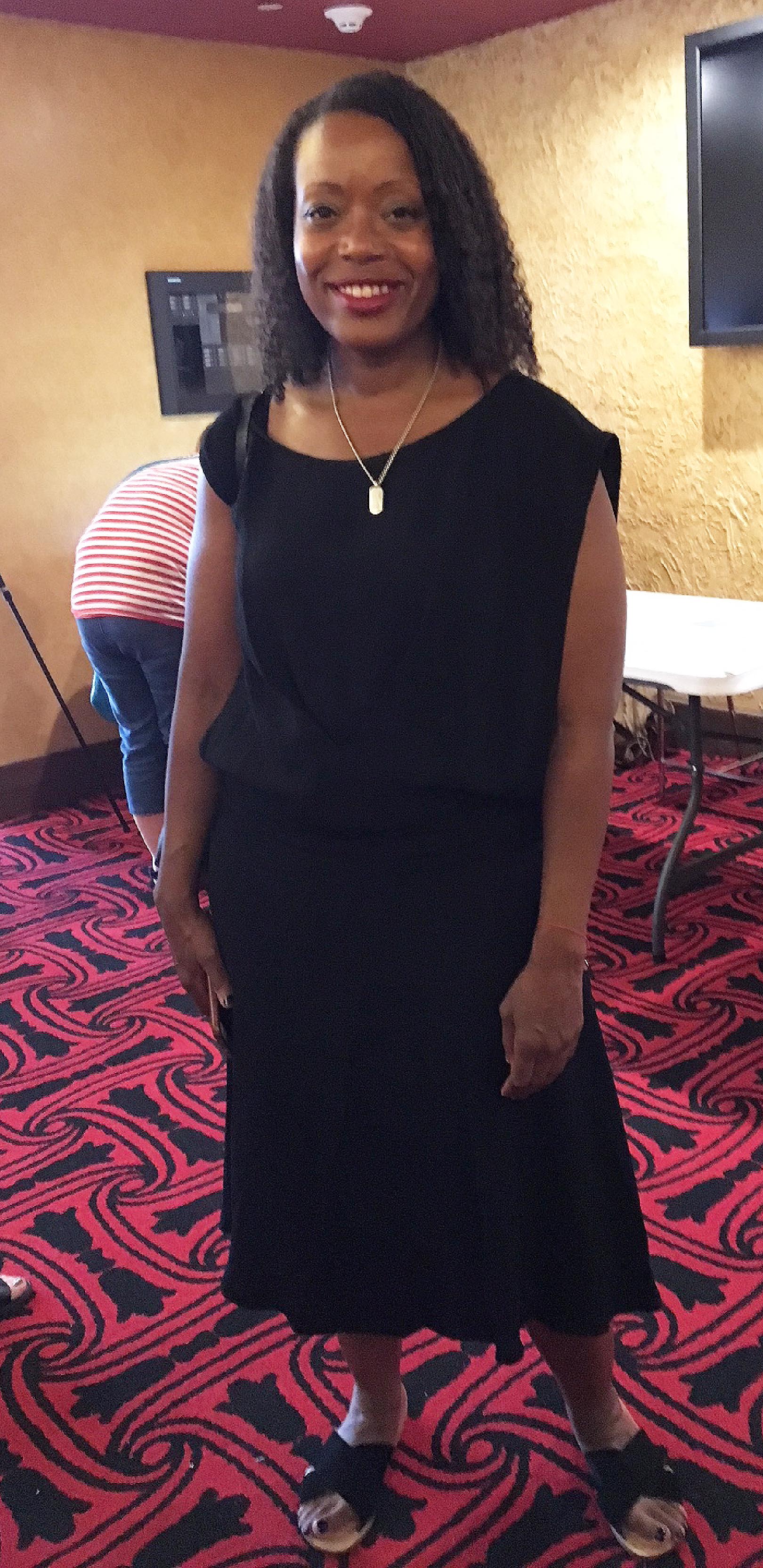
Designer Tracy Reese (Photo by Patsy Isenberg)
After the screening a Q & A session featured a panel of Chin, Reese, Premeaux and Rebecca Arnell from N.E.W. Life. Flint residents Barbie Biggs and Lee Bell later joined the panel to talk about the bottle collection process and take questions. Each panelist spoke of his or her role in the project.
Many audience members asked whether the clothing will be marketed. Chin answered he refers to the Flint Fit project as “phase one.” Reese and Premeaux agreed. Chin said, “I really appreciate the transparency and honesty from Tracy and Ben to give this particular guidance to begin. This show in New York, the film, has been intended to be followed up on… we can report to you again honestly as we move this forward.”
Reese said the idea of producing and selling the product has to be based on “a very clear plan and a clear end-customer who will pay… the idea of reaching your customer with the correct product is key…doing the research and understanding what that product can be.” Chin and Reese agreed a business plan is an essential next step.
As to the film, Premeaux said, “It was interesting to travel and be a part of every single part of the process, go to every part of the triangle… everybody had a part to play and I was the lucky one that got to see the whole thing.” Flint Fit was often described as a triangle and Chin, as the conceptual artist who was commissioned by the Queens Museum for the project, said he saw the triangle reference as “poetic.”
Send Off
At the very end of the evening, Amber Hasan, a local spoken-word and rap artist, capped off the event with a performance.
More information about the project and updates on the project as it evolves are available at www.flint-fit.com.


You must be logged in to post a comment.